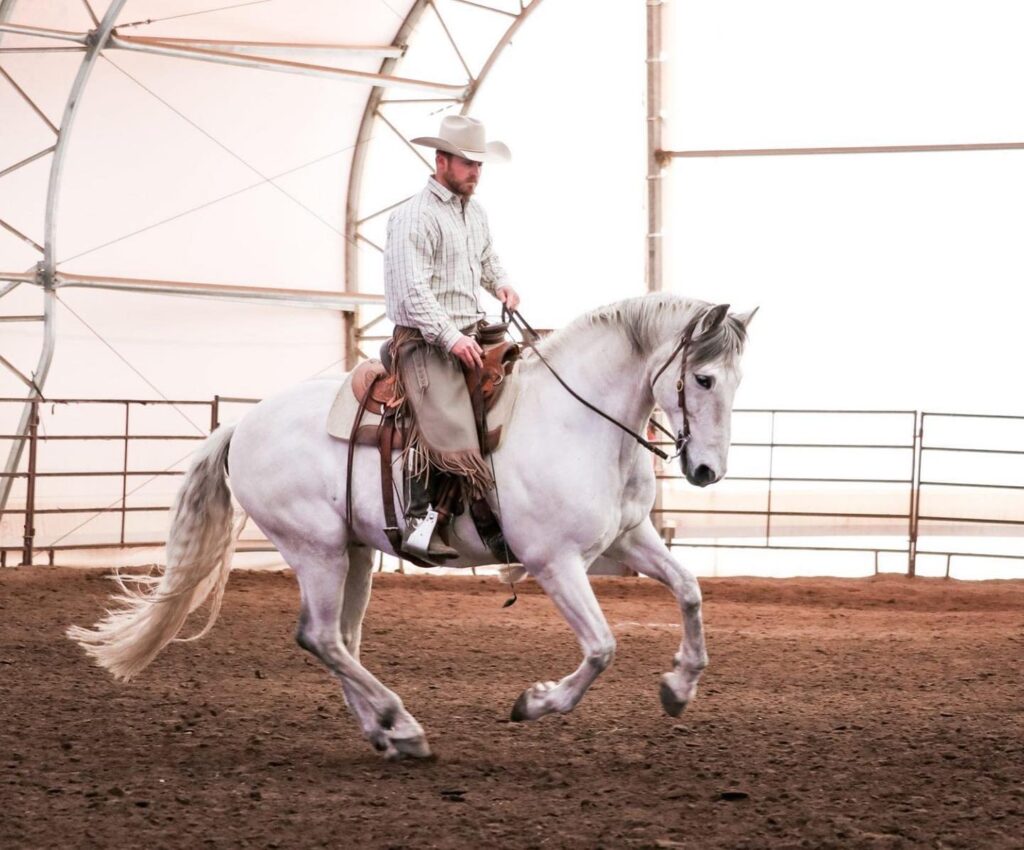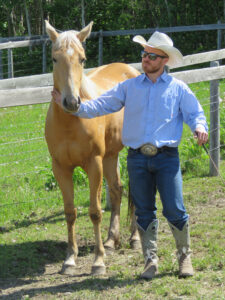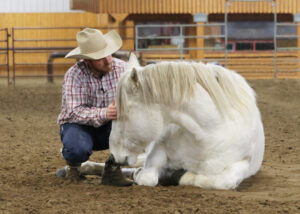
A true partnership with a horse starts by meeting your horse’s needs, which in turn inspires the horse to want to work with you and allows him to give his best in every way.
By Josh Nichol
If you ask people what they mean when they say they want to build a partnership with their horse, you will hear things like, “I want to feel that my horse and I are working together,” and “I want my horse to enjoy being with me as much as I enjoy being with him.” These are important and worthwhile aspirations, and if we can achieve them, they definitely make training and riding more enjoyable for both horse and human. However, I would add that a true partnership with a horse requires that you make a constant and sincere effort to meet your horse’s needs, not just to fulfill your own. Meeting a horse’s needs allows you to add value to your horse’s life instead of just placing demands on your horse, and that’s when you discover the tremendous heart and willingness that a horse will give freely if they are inspired to do so, but which can never be created through force.
Unfortunately, wanting to build that kind of relationship with a horse does not always show us a clear way to get there. As I see it, one of the most common stumbling blocks to achieving a real partnership with a horse is the idea that our interactions with horses must be based on a paradigm of dominance and submission. While this idea is quite pervasive in the horse world, try to imagine yourself in a partnership with someone who is constantly bossing you around and expecting you to do whatever they say, regardless of how that makes you feel. That wouldn’t be much of a partnership, would it?
Nonetheless, many training programs use dominance and submission as their primary foundational element. People often gravitate to such programs having been told that all horses want a leader, and that the only way you can become that leader is to demand “respect”. But when people are really tuned in to their horses, this approach will generally leave them with a twist in their gut or a heavy heart. The teacher using such methods may be very successful, but try looking into the eyes of the horse they are training, and you will see whether that horse feels like a valued and respected partner or a tool being made to perform various actions. A horse trained with dominance-based methods will often look like he has gone away inside himself somewhere, his expression distant or shut down. A horse taught with a more relational approach will have life in its eyes, along with both calmness and curiosity.

The horse’s expression is a useful guideline to how the horse is feeling, as a horse’s eye will show both calmness and interest if they feel positively engaged, as we see in this young, unhandled filly.
Of course, we all want our horses to do what we ask of them, when we ask it, and we also need to keep ourselves safe. But if we accomplish these things through dominance, we simply cannot fulfill the basic tenets that make any type of partnership work. When two people are partners in a small business, for example, there is an expectation of benefit to both parties, both parties are willing participants in the endeavors they undertake, and there is a solid level of trust that both partners are working for each other’s good as well as their own. These tenets are no different in a partnership with a horse. To fulfill them, we must strive to make our interactions with our horses worthwhile from their perspective.
This brings us back to the idea of meeting the horse’s needs, which is the foundational element of my Relational Horsemanship style of training. In this context, I am talking about the horse’s three basic relational needs: Mind, Space and Pressure. To meet the horse’s Mind need, we must show the horse that he can rely on us to deal with whatever is going on in the environment so that he doesn’t have to. He thus learns that if he keeps his mind with us instead of focusing on every possible concern around him, and if he allows us to take care of the things he is mindful of, he not only stays safe but feels much more at ease.
To meet the horse’s Space need, we need to demonstrate a fluency in the spatial language horses use to communicate. This is not about “getting after” the horse or “showing the horse who’s boss”. It is simply about consistently demonstrating that we are calm and confident in our ability to be present, aware and communicative through our space. Providing this clarity draws our horses to us and brings them a deep degree of peace, as they do not have to question or worry about whether they need to be directing us spatially. When horses are unsure about their spatial relationship with us, they often do things that get them labelled as pushy or rude. Most of the time, the horse is simply unsettled due to a lack of clarity in our spatial communication, and they are doing the only things they know how to try to find out where they stand. I have found that the best solution, if you are truly looking to build a partnership, is not to dominate the horse, but rather to show them that you “own your own space” (see this YouTubevideo for a demonstration), which gives them the clarity they need without damaging the relationship.
Horses also have a profound need to understand and feel able to control anything they perceive as a pressure, whether that is something touching them physically or something that could be a potential danger somewhere in their vicinity. For example, if they see your neighbor’s dog coming towards them and believe the dog is dangerous, that is a pressure, and they might feel the need to flee from that pressure. However, if experience has shown the horse that taking a step or two towards the dog will make the dog run away, the horse feels in control of the situation and will not be worried about the dog. Similarly, meeting a horse’s Pressure need means helping the horse learn to think through situations in which they encounter pressures, rather than simply reacting to them. When a horse understands that processing a pressure calmly keeps them safe, their confidence grows in leaps and bounds, both in themselves and in you, as you consistently guide them to a good place whenever they have a doubt. By helping the horse master pressure in this way, you truly empower the horse, enabling them to navigate the world with less fear.
Teaching a horse how to think through pressure is not at all the same as what many people call “desensitizing” or “sacking out” in which the horse is forced to tolerate inescapable pressures. This type of training can lead to the horse experiencing a state that behavioralists call “learned helplessness”, which often makes a horse appear calm and quiet when they are really just swallowing their worries. Eventually, those worries will bubble up one way or another, leading to situations where a supposedly well-trained horse suddenly does something dangerous “out of the blue”. Rather than risk such moments by diminishing the horse’s sense of self, I prefer to empower the horse by showing them how to navigate the world with assurance.
The through-line in all of this is that meeting the horse’s needs allows them to feel better, calmer, and more confident going through life, all of which is of tremendous value to a prey animal. Help a horse to feel safe, relaxed and self-assured through your teaching, and that horse will want to be around you and enjoy working with you. This is an absolutely critical aspect of building a true partnership.

This is my wonderful horse Max, who on several occasions has sought me out and has then chosen to lay down next to me. I believe he does this because he feels safe in my presence because he knows that my top priority is to always meet his needs and bring him peace. I never taught or asked him to do this — it was entirely his own idea.
Therefore, to develop an excellent partnership with a horse, you must continually work on two elements on your side of the relationship. First, be willing to make meeting your horse’s needs a top priority at all times. Aim for him to feel safe with you and with what you ask of him, not worried or fearful. Second, be attentive to what is coming from you. While we all have our ups and downs, your goal should be to generally give off energy, thoughts, and intentions that your horse would enjoy being around. An extra benefit of working on this aspect is that as you begin to take responsibility for your own energy and consider how it affects your interactions with horses, you will soon see that the same thing applies to all the relations in your life. You may then find yourself forming better partnerships all around, not just with your horse!
To learn more about Josh Nichol and his Relational Horsemanship approach to training, check out his webpage: JoshNichol.com
Want to read more great articles like this one? Click the “subscribe” button on the bottom left of this page and you’ll get notified when new articles are posted!